Chapter: Mechanical : Dynamics of Machines : Forced Vibration
Solved Problems: Forced Vibration
SOLVED PROBLEMS
1. Derive the relation for the displacement of mass from the equilibrium position of the damped vibration system with harmonic forcing.
Consider a system consisting of
spring, mass and damper as shown in Fig. 23.19. Let the system is acted upon by
an external periodic (i.e. simple
harmonic) disturbing force,
Fx = F cos ω .t where F = Static force,
and
ω = Angular velocity of the periodic
disturbing force.
When the
system is constrained to move in vertical guides, it has only one degree of
freedom. Let at sometime t, the mass is
displaced downwards through a distance x from its mean position.
The
equation of motion may be written as,
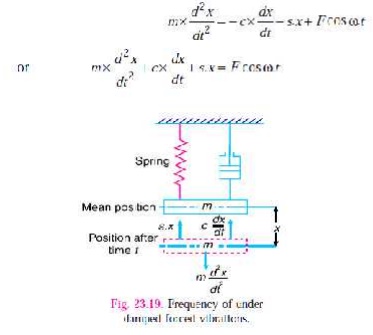
This equation of motion may be solved either by
differential equation method or by graphi-cal method as discussed below :
1. Differential equation method
The equation (i) is a differential
equation of the second degree whose right hand side is some function in t. The solution of such type of
differential equation consists of two parts ;
one part is the complementary function and the
second is particular integral. Therefore the solution may be written as
x=x1+x
where x1 = Complementary function, and x2 =
Particular integral.
The complementary function is same as discussed
in the previous article, i.e.
x1 = Ce−at cos (ωd t− θ ) . . .
(ii) where C and θ are constants. Let us now find the value of particular
integral as discussed below :
Let the particular integral of
equation (i) is given by
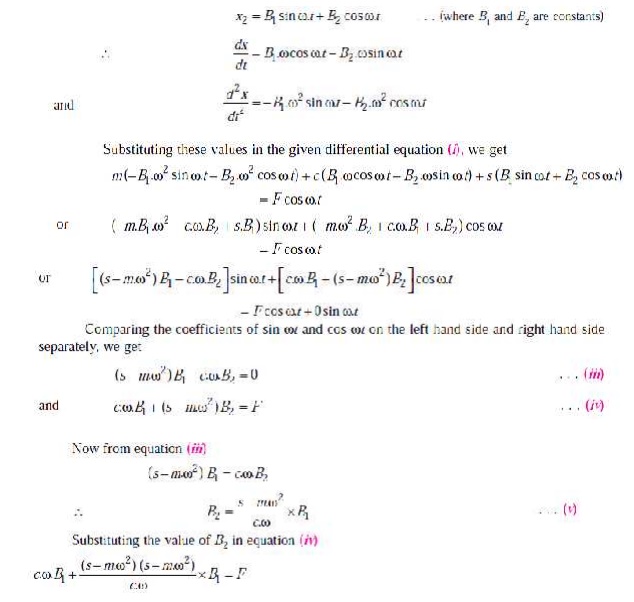
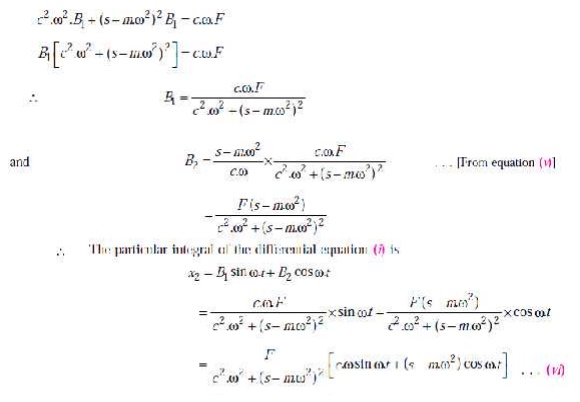
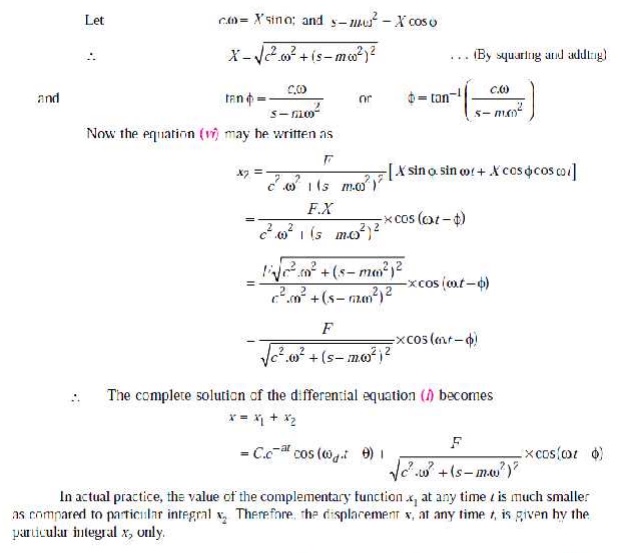

2. A mass of 10 kg is
suspended from one end of a helical spring, the other end being fixed. The stiffness of the spring is 10 N/mm. The
viscous damping causes the amplitude to decrease to one-tenth of the initial
value in four complete oscillations. If a periodic force of 150 cos 50 t N is
applied at the mass in the vertical direction, find the amplitude of the forced
vibrations. What is its value of resonance ?
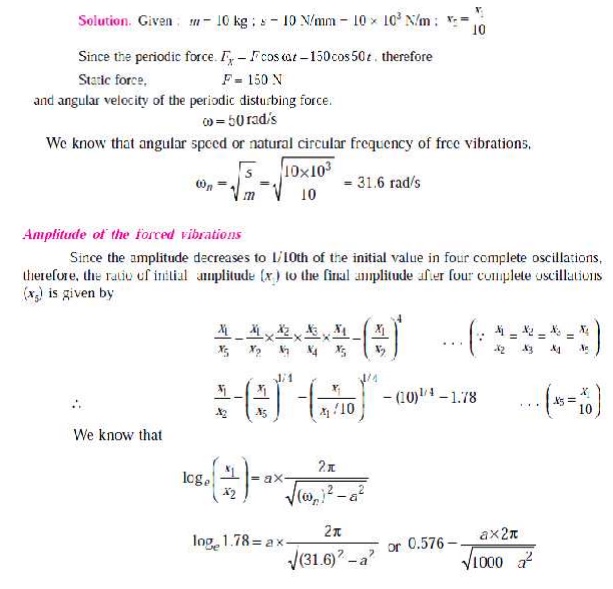
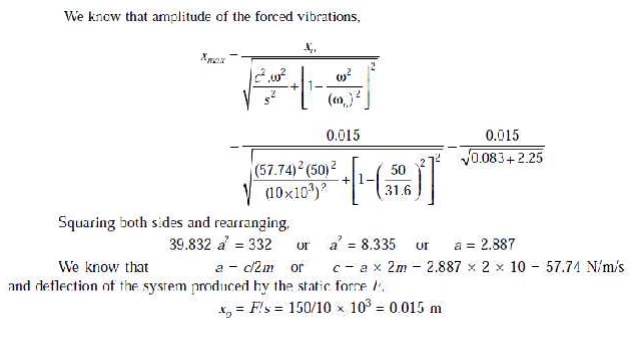
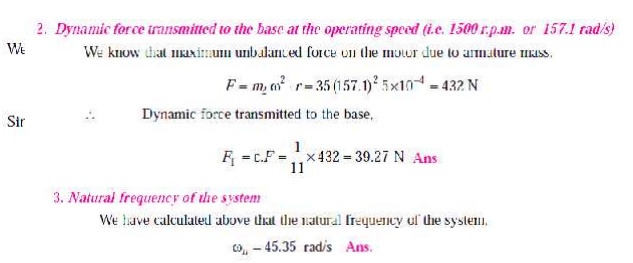
3. The
mass of an electric motor is 120 kg and it runs at 1500 r.p.m. The armature
mass is 35 kg and its C.G. lies 0.5 mm from the axis of rotation. The motor is
mounted on five springs of negligible damping so that the force transmitted is
one-eleventh of the impressed force. Assume that the mass of the motor is
equally distributed among the five springs.
![]()
![]()
Determine : 1. stiffness of each spring; 2. dynamic
force transmitted to the base at the operating speed; and 3. natural frequency
of the system.
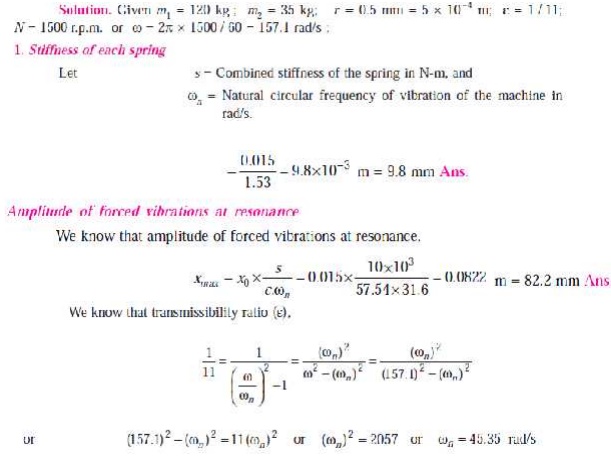
4. What do you understand by transmissibility?
Describe the method of finding the transmissibility ratio from unbalanced
machine supported with foundation.
A
little consideration will show that when an unbalanced machine is installed on
the foundation, it produces vibration in the foundation. In order to prevent
these vibrations or to minimize the transmission of forces to the foundation,
the machines are mounted on springs and dampers or on some vibration isolating
material, as shown in Fig. 23.22. The arrangement is assumed to have one degree
of freedom, i.e. it can move up and
down only.
It may be noted that when a
periodic (i.e. simple harmonic)
disturbing force F cos ω t
is applied to a machine of mass m supported by a spring of stiffness s, then the force is transmitted by
means of the spring and the damper or dashpot to the fixed support or
foundation.
The ratio of the force transmitted
(FT) to the force applied (F) is known as the isolation factor or transmissibility ratio of the spring support.
We have discussed above that the
force transmitted to the foundation consists of the fol-lowing two forces :
1.
Spring
force or elastic force which is equal to s.
xmax, and
2.
Damping
force which is equal to c. ω .xmax.
Since these two forces are
perpendicular to one another, as shown in Fig.23.23, therefore the force
transmitted,
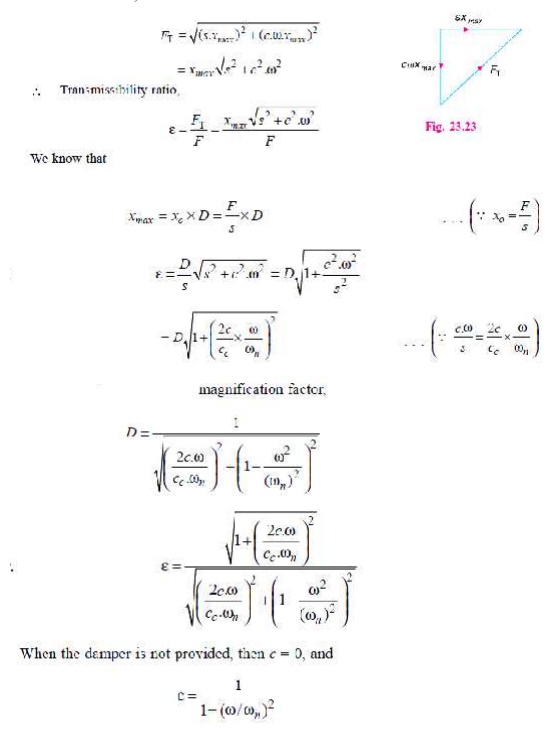
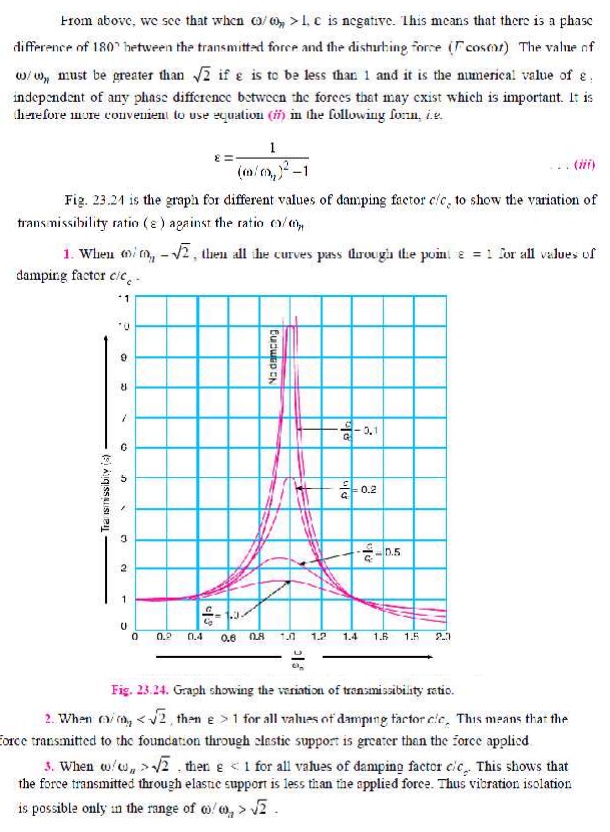
5. A machine has a mass of 100 kg and unbalanced
reciprocating parts of mass 2 kg which move
through a vertical stroke of 80 mm with simple harmonic motion. The machine is
mounted on four springs, symmetrically arranged with respect to centre of mass,
in such a way that the machine has one degree of freedom and can undergo
vertical displacements only.
Neglecting damping, calculate the combined stiffness of the
spring in order that the force transmitted to the foundation is 1 / 25 th of
the applied force, when the speed of rotation of ma-chine crank shaft is 1000
r.p.m.
When the machine is actually supported on the
springs, it is found that the damping reduces the amplitude of successive free
vibrations by 25%. Find : 1. the force transmitted to foundation at 1000
r.p.m., 2. the force transmitted to the foundation at resonance, and 3. the
amplitude of the forced vibration of the machine at
resonance.

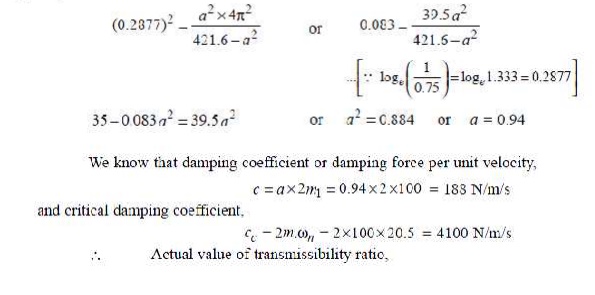
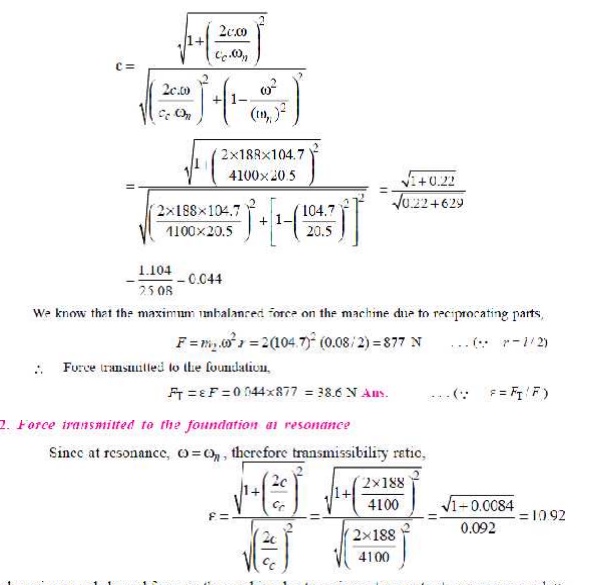
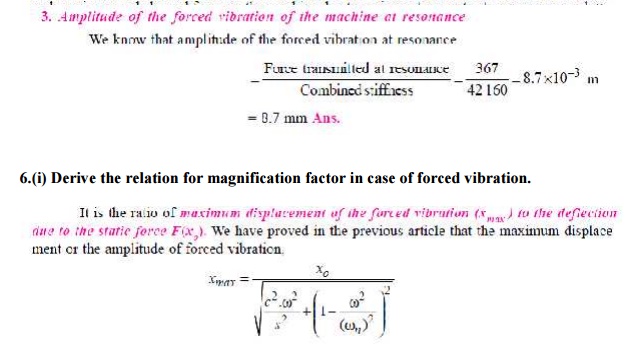
6.(i) Derive the relation for magnification factor
in case of forced vibration.


6.(ii) A single cylinder vertical petrol engine of
total mass 300 kg is mounted upon a steel chassis frame and causes a vertical
static deflection of 2 mm. The reciprocating parts of the engine has a mass of
20 kg and move through a vertical stroke of 150 mm with simple harmonic motion.
A dashpot is provided whose damping resistance is directly proportional to the
velocity and amounts to 1.5 kN per metre per second.
Considering that the steady state of vibration is
reached ; determine : 1. the amplitude of forced vibrations, when the driving
shaft of the engine rotates at 480 r.p.m., and 2. the speed of the driving
shaft at which resonance will occur.
Solution
: Given. m = 300 kg; δ = 2 mm = 2 × 10–3 m ; m1 = 20 kg ; l = 150 mm
= 0.15 m
; c = 1.5 kN/m/s = 1500 N/m/s ; N = 480 r.p.m. or ω = 50.3 rad/s
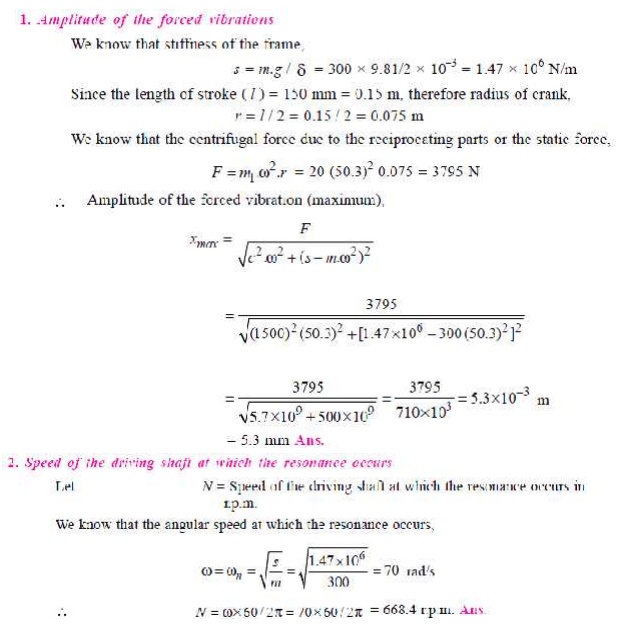
1.
A machine of
mass 100 kg is supported on openings of total stiffness 800 kN/m and has a
rotating unbalanced element which results in a disturbing force of 400 N at a
speed of 3000 r.p.m. Assum-ing the damping ratio as 0.25, determine : 1. the
amplitude of vibrations due to unbalance ; and 2. the transmitted force. [Ans. 0.04mm
; 35.2 N]
2.
A mass of 500
kg is mounted on supports having a total stiffness of 100 kN/m and which
provides viscous damping, the damping ratio being 0.4. The mass is constrained
to move vertically and is subjected to a vertical disturbing force of the
type F
cos ω t. Determine the frequency at which
resonance will occur and the maximum allowable value of F if the amplitude at resonance is to be restricted to 5mm
[Ans. 2.25
Hz ; 400 N]
3.
A machine of
mass 75 kg is mounted on springs of stiffness 1200 kN/m and with an assumed
damping factor of 0.2. A piston within the machine of mass 2 kg has a
reciprocating motion with a stroke of 80 mm and a speed of 3000 cycles/min.
Assuming the motion to be simple harmonic, find : 1. the amplitude of motion of
the machine, 2. its phase angle with respect to the exciting force, 3. the
force transmitted to the foundation, and 4. the phase angle of transmitted
force with respect to the exciting force. [Ans.
1.254 mm ; 169.05° ; 2132 N ; 44.8°]
Related Topics